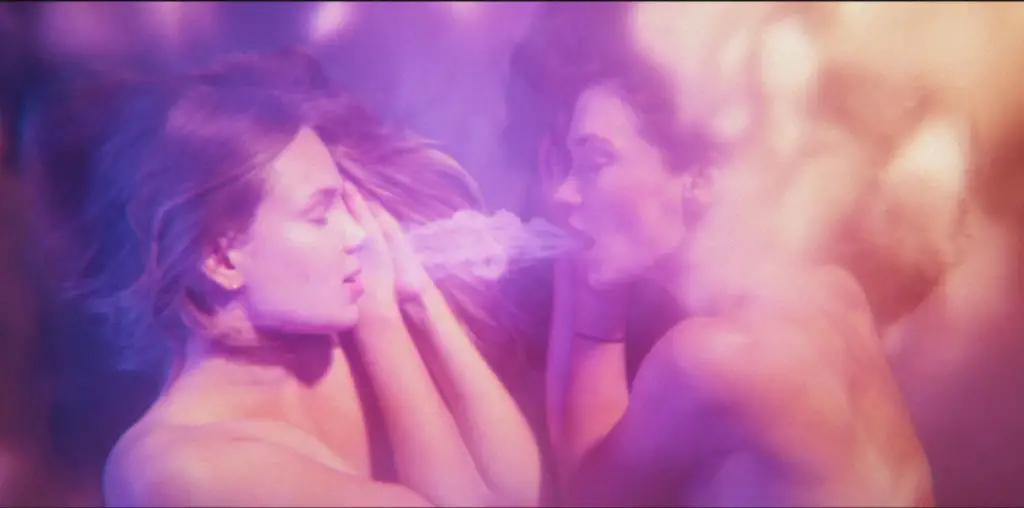
A young girl named Pug climbs on a jungle gym in a school yard and tears pages from her personal spelling book, entitled “A History of Others”: “A is for Arson, B is for Boat… ” Below her, a boy named Tony sets fire to the pages. A strange man pauses outside the schoolyard fence and yells for them to stop, then introduces himself as “Snake.” The adult Pug watches the scene, until her curiosity about the sound of a ringing alarm propels her into the school building, and thus into a series of dreamlike adventures in her subconscious. Before this short film is over, we will have visited a strange bar which shows cartoons, a burning boat, a giant floating piece of dung, and many other disturbing and fascinating corners of Pug’s imagination.
Ormand’s short, but extremely powerful and beautifully realized film is in the tradition of dream narrative films, reminiscent of the works of Ulrike Ottinger, Fellini, and Richard Foreman’s “Strong Medicine.” I was quite impressed with the way Ormond, working, in her own words, with “a budget of nothing” has created a film with a dizzying variety of visual landscapes and disorienting dreamlike spaces that resembles films made with ample budgets. The visual look of “Jungle Gym” is unnerving, resonant, and right on target. Ormond writes in her production notes that she ignored the common advice that one should not make a film of a dream. I think the real reason for this advice is that it is almost impossible to do it well; to capture on film the elusive blend of disorienting changes and underlying unity which makes dreams so compelling. Ormond has tapped deeply into her intuition and achieves the real look, sound, feel, even the smell of dreams with uncanny accuracy.
She uses a variety of intelligent means to achieve the authentic dream state feeling. Slow motion, images which leave traces, and split screens are clichés of experimental film, but in “Jungle Gym” they always fulfill a specific function; derealizing the sense of time and location, in order to achieve the sensation that the protagonist is simultaneously in several locations and several different layers of reality. We feel that she can easily be on a burning boat which sinks into the sea; watching a film of the boat, and back in the schoolyard, all at once. The acting style, flat, affectless, almost a parody of what we think of as ‘bad acting,’ works perfectly, in this instance, to evoke a dream world. The actors pronounce their lines as if asleep or performing a predetermined ritual, making one feel that language is not being used for utilitarian communication, as in waking life, but rather as a magical invocation of a sequence of related images and feelings. Steve Schenkel’s score, which takes ordinary tunes like “twinkle twinkle little star” and carnival music and gives them a menacing, twisted air, adds perfectly to the dream effect.
The strong writing is the key to what makes “Jungle Gym” so convincing. Ormond strikes an effective balance by introducing disorienting transitions, such as the abrupt change from the underground bar to the burning boat, while maintaining enough continuity so that we always believe that the heroine is undergoing a series of connected adventures, and we want to know what happens to her next. (In fact, when we follow Pug into the burning boat, she seems, with the logic of a dream, to have stepped inside of an animated cartoon of the boat, which was being shown in the bar.) The fact that the underlying images (fire, snakes, filmmaking) are all interconnected and reappear in some form in every scene, helps to keep us believing that, like a dream, the film is really a highly coherent exploration of interrelated feelings and emotional issues.
The film employs a number of well-worn Freudian clichés, such as a woman who is afraid of snakes, or bathroom anxiety images. But, after all, these images are clichés because they really appear in many people’s dreams, and Ormond gives them enough emotional detail that they seem absolutely real. Her editing and sense of timing is also pitch perfect. Each image gives way to the next just when it needs to.
“Jungle Gym” makes a powerful feminist statement. The “movie” which Pug keeps trying to escape from, with its “crappy” plot, is also the traditional male view of the female role, which is why all the women in the dream are forced to dress like Marilyn Monroe. “It’s MY movie,” asserts Pug, trying to gain control of the plot. “You’re not in it,” observes the Snake. “I wrote it, I directed it” is the answer of both the adult and child Pugs, staking claim to two roles, which are not traditionally available to women. Later, when she is in the women’s room, wrestling with the giant snake, she escapes not by directly killing the snake but by punching her way through the paper walls of the bathroom, made from storyboards of the movie (and incidentally hitting the school principal.) Her cry of rage as she escapes from the bathroom is enormously liberating.
Meredith Bussen’s performance as the heroine is engaging and refreshing. Her Pug uses common sense and humor to snap back at the irrational figures from her dream who constantly torment her. She creates a vivacious version of the classic Alice in Wonderland figure of a sensible girl caught in an irrational fantasy.
In a short amount of time, “Jungle Gym” pulls us deeply into the strange inner world of an artist struggling to assert her voice and her identity, showing us a dream world both mesmerizing, funny, bizarre, and emotionally resonant
